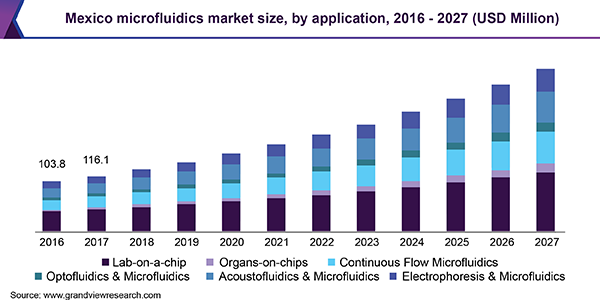May 2020 | Report Format: Electronic (PDF)
The global microfluidics market size is expected to reach USD 31.6 billion by 2027, according to a new report by Grand View Research, Inc., registering an 11.3% CAGR over the forecast period. Demand for microfluidic-based devices is expected to surge owing to introduction of novel technologies such as digital microfluidics. These techniques allow on-chip biochemical analysis, thereby driving adoption.
Rise in the adoption of microfluidics for point-of-care diagnostics is expected to have a significant impact on market growth. Industry players such as Abbott, Roche, and Danaher have already incorporated this technology in their existing diagnostic devices and are exploring the scope of digital microfluidics. For instance, Philips’ Minicare I-20 handheld device provides accurate and rapid results for the diagnosis of heart attacks.
Large investments targeted toward the development of microfluidics and promoting their adoption are expected to create opportunities for the expansion for automated as well as miniature devices. For instance, according to an article published in 2018, there have been large-scale investments in “sample-to-answer” microfluidic automated testing in recent years.
Microfluidics has not only been proven beneficial in biological bench-work but also several medical and pharmaceutical applications, including diagnosis of infectious diseases and treatment of cancer. The technology aids in the fabrication of functional living tissues and artificial organs. Companies such as Abbott, Roche, Cepheid, and Becton, Dickinson and Company (BD) are integrating such technologies with in-vitro diagnostics (IVD). Samsung LABGEOPT10 and Abbott i-STAT are examples of single-step blood glucose testing assays that can work on a small sample volume (a single blood drop).

Further key findings from the study suggest:
- The medical/healthcare segment dominated the market by technology owing to rise in demand for new molecular diagnostic tests with enhanced sensitivities, shorter turnaround time, and increased accuracy at minimal costs
- PCR & RT-PCR were the largest revenue-generating medical technology in 2019 and the segment is expected to retain its lead throughout the forecast period. Digital PCR in combination with a microfluidic device allows a large amount of PCR reaction mix to be distributed into nanoliter-sized volumes automatically
- The organs-on-chips application segment is expected to register the fastest CAGR throughout the forecast period. The method can potentially reduce the failure rate in drug development pipelines, thereby reducing the time and money associated with drug development
- By material, polydimethylsiloxane (PDMS) accounted for the largest revenue share in 2019. The material is used to fabricate microfluidic-based devices because of its nontoxicity, robustness, optical transparency, permeability, biocompatibility, elastomeric features, and low cost.
- North America dominated the global microfluidics market in 2019 and is expected to retain its dominance over the analysis period. Local presence of leading players, availability of funds and research capital, and launch of novel sample volume screening technologies drives the North America market
- Asia Pacific is expected to witness the fastest growth owing to rise in aging population, demand for point-of-care diagnostic tests, and presence of academic institutions such as the Institute of Microchemical Technology (IMT), Japan, that are focused on microfluidic-based research
- Illumina, Inc.; PerkinElmer, Inc.; Agilent Technologies, Inc.; Danaher Corporation; Bio-Rad Laboratories, Inc.; Life Technologies Corporation; Abbott Laboratories; F. Hoffmann-La Roche Ltd; and Fluidigm Corporation are some of the key players operating in the global market